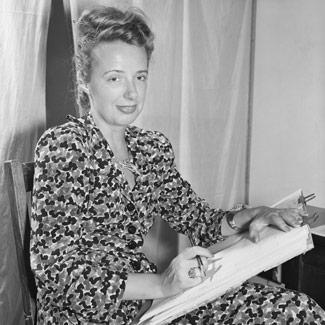Claire McCardell (Designer/Creator of the American Look)
 Claire McCardell (1905–1958) was an American fashion designer in the arena of ready-to-wear clothing in the 20th century. From the 1930s to the 1950s, she was known for designing functional, affordable, and stylish women’s sportswear, and is today acknowledged as the creator of the “American Look” , a casual approach to fashion that rejected the formality of French couture.
Claire McCardell (1905–1958) was an American fashion designer in the arena of ready-to-wear clothing in the 20th century. From the 1930s to the 1950s, she was known for designing functional, affordable, and stylish women’s sportswear, and is today acknowledged as the creator of the “American Look” , a casual approach to fashion that rejected the formality of French couture.
Born on May 24, 1905 in Frederick, Maryland to Adrian and Eleanor McCardell, Claire McCardell took an early interest in fashion. As a child, she would cut figures from her mother's fashion magazines in order to create paper dolls and began sewing her own clothes as a teenager. In 1943 she married the Texas-born architect Irving Drought Harris, who had two children by an earlier marriage, and established a home base in Manhattan.
First attending Hood College in Maryland from 1923-1925 at the age of 16, McCardell enrolled in Parsons (then known as the New York School of Fine and Applied Art) in 1925 to pursue her interest in fashion . There, she received a grounding in the general principles of art and design as well as the more specialized disciplines of costume illustration and design.
For her second year of study, she attended the school's branch in Paris. The students were often invited to view the collections at important couture houses, including that of Madeleine Vionnet. By purchasing and disassembling Vionnet end-of-season samples, she learned about that designer's pioneering use of the bias cut and incorporated the technique in her own work, simplifying the original lines in order to render the finished garments more accessible to American women. In 1928, after completing a third year in the school, this time at the New York campus, she received her certificate in Costume Design.
McCardell then had a series of short-term jobs before becoming the assistant to New York fashion designer Robert Turk. Turk assumed the position of head designer for Townley Frocks, Inc. in 1931 and brought McCardell with him to the company. Soon thereafter, Turk drowned in a swimming accident, and McCardell stepped up to design a collection for the 1931 spring showing. She went on to produce groundbreaking designs under the Townley Frocks name until 1939, when the operation closed its doors. Hattie Carnegie then hired McCardell to work for her famed dressmaking firm, but her designs were not successful with Carnegie's clients, who were in search of more elaborate merchandise. In 1940, just before leaving Carnegie, McCardell attended her last Parisian fashion show, preferring from then on to avoid any French influence on her clothing.
After designing briefly for Win-Sum, a low-end manufacturer, McCardell returned to Townley Frocks, which reopened in 1940 under the management of Adolph Klein. The importance of her work was recognized when the company soon began issuing its product under the label "Claire McCardell Clothes by Townley," making her one of the first American designers to have name recognition.
By the time the United States entered the World War II in 1941, the country was cut off from France and its hegemony in clothing design. In addition, the war effort demanded a rationing of fabrics. These setbacks did not adversely affect McCardell, who already was steering clear of French influence and whose designs made frugal use of material. In one fashion showing, for example, she clad all of her models in fabric ballet slippers due to leather rationing, sometimes covering the original material with fabric from the garment to match.
In 1944, McCardell, now a widely recognized designer, returned to Parsons as a critic and instructor, a position she continued to hold for the rest of her life. That same year brought her the first of two Winnies, the most prestigious award in the fashion industry. When Lord and Taylor began their “American Look” campaign to promote American designers in the face of France’s crippled fashion industry, the store put McCardell's designs for Townley at the fore of its marketing campaign. By the end of the forties, Townley was Lord and Taylor's best ready-to-wear seller. In following years McCardell began licensing the use of her name to such companies as Accessocraft, which made costume jewelry.
McCardell received multiple honors in the 1950s. President Harry S. Truman presented her with the Women's National Press Club Award in 1950. With this award, she became the first fashion designer to be voted one of America's Women of Achievement. In 1953, Frank Perls Gallery, of Beverly Hills, mounted an exhibition of McCardell's garments that spanned over 20 years of her career. McCardell eventually earned an appearance on the cover of Time magazine on May 2, 1955 and published her book What Shall I Wear? The What, Where, When, and How Much of Fashion in 1956. In 1990 Life magazine named her one of the 100 most important Americans of the twentieth century, 37 years after her death.
- Tags: designer fashion inspiration success